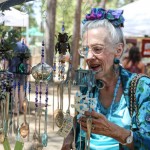
The draft Corridor Management Plan (CMP) for the Palms to Pines Scenic Byway is available for public comment. The CMP is the result of five workshops over the past year. The last of the workshop series was completed on Nov. 17.
“The workshops went great,” said Timory Peel, natural resource specialist for the U.S. Forest Service’s Recreation Solutions Enterprise Team. “We had about 16 folks from the communities, State Parks, the Santa Rosa Tribe and Caltrans attend across the three nights. We presented copies of the draft plan, discussed potential ‘next steps’ and current funding opportunities through the [Federal Highway Administration] discretionary program.” Scenic byways provide an opportunity for travelers to enjoy the unique features of an area, while providing local communities an opportunity to increase tourist revenue.
To receive the official designation as a National Scenic Byway, a route must be a state-designated scenic route, possess multiple intrinsic qualities that are nationally significant and have a completed corridor management plan.
After working together for more than a year, workshop participants seemed to agree that the Palms to Pines Scenic Byway has the intrinsic features and visitor services required for designation as a National Scenic Byway through the Federal Highway Administration.
Formal recognition as a National Scenic Byway would provide additional benefits to area visitors, nearby residents and businesses, and bring opportunities to surrounding communities.
The draft CMP identifies this action as a valuable opportunity to use the route’s designation as part of a larger strategy to protect the intrinsic features of the surrounding ecosystems. The goals for the CMP reflect the consensus among workshop participants (e.g., community residents and agency personnel) about their vision for the route.
While there is consensus that the area is special and needs to be protected in perpetuity, there is less agreement about the best approach to protecting the corridor and the surrounding ecosystems.
“The draft plan was well-received, and although there is not full support for seeking National Scenic Byway designation at this time, participants have expressed a desire to continue to work together into the next year on some of the implementation items,” Peel wrote after the fifth workshop.
Some folks felt that another national designation will simply draw more visitors to the area. Others feel that a national designation will make it easier to secure resources to preserve the intrinsic features of the scenic corridor, to encourage stewardship of these natural and cultural resources and to create a better driving experience for all (e.g., visitors, commuters and residents).
The plan identifies several benefits beginning with national recognition. National Scenic Byway recognition identifies the premier scenic routes in the U.S., and brings recognition to the agencies, organizations and communities that sought designation. Identification of the Palms to Pines Scenic Byway on state and federal maps and on auto club brochures can lead to more tourism opportunities for the area.
Secondly, the designation can lead to increased local pride and provide residents an opportunity to showcase the beauty of their region. The CMP gives stakeholders a forum to discuss what they value and want to feature in their communities. It also identifies how to preserve these qualities while encouraging thoughtful economic growth.
Finally, recognition can be a path to securing federal funding to accomplish many projects associated with Byway designation.
If the Palms to Pines Scenic Byway were to be designated a National Scenic Byway, the route would be eligible for federal funding through the National Scenic Byways Program. These funds could be used to develop interpretive facilities, information kiosks, restrooms and other needed road improvements.
Approximately half of the byway traverses the San Jacinto Ranger District of the San Bernardino National Forest. The Palms to Pines Scenic Byway is a residential route as well as a visitor destination.
The Palms to Pines Scenic Byway was designated as a California State Scenic Highway in two sections and times (October 1971 and March 1972) and as a National Forest Scenic Byway in July 1993.
Riverside County road crews, assisted by prison labor, finished the Hemet to Idyllwild route in 1929. By 1932, Riverside County prison labor crews and the Federal Bureau of Public Roads had constructed the remainder of SR 74 from Mountain Center to Palm Desert. The original Palms to Pines highway fulfilled the utilitarian purpose of providing easier automobile access to Mount San Jacinto State Park from Hemet, Banning and the desert side of the mountains. Today’s drivers essentially still follow the original engineered route.
Comments and edits are invited and may be sent to: Timory Peel, USDA FS Recreation Solutions, 12858 US Hwy 2, Troy, MT 59935, via email to [email protected] or by telephone to (406) 295-7467. To be most helpful, please provide feedback by Jan. 15, 2012.













